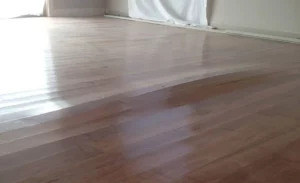Ever wonder what laminate flooring really is? Imagine layers stuck together to create a tough surface that looks like wood or stone, but without the big price tag. It’s a go-to for many because it’s tough and comes in lots of cool designs. When we think of updating our floors, we’ve got options like wood, vinyl, or carpet, but each has its own way of setting up, like glueing or snapping pieces together.
Getting the foundation right is super important for laminate floors. A solid and even base makes sure your floor stays awesome for years. Now, here’s a big question we hear a lot: “Can we put laminate over tile?” That’s what we’re here to chat about! Our team will dig into this and give you the scoop on whether your old tile can serve as a base for shiny new laminate.
Advantages of Laminate Flooring
Tough as Nails
We love laminate flooring because it’s super tough. It’s got this clear layer on top that keeps it safe from scratches and spills. If you take good care of it—like sweeping and mopping now and then—it can look great for up to 25 years. That’s a lot of playtime and parties it can handle!
Looks for Less
Want your floor to look fancy without spending a ton? Laminate’s got your back. It comes in all sorts of colors and styles. It can even look like wood or stone, but without the big price tag. So, you can make your place look awesome on a budget.
Easy-Peasy Cleanup
Keeping laminate floors clean is a breeze. Just grab a broom or a damp mop, and you’re all set. No need for fancy cleaners or spending your whole weekend on your hands and knees. It’s a big win for anyone who’d rather be doing, well, anything else!
Save Your Pennies
Laminate flooring is kind to your wallet. It costs less than a lot of other floors, but it still lasts a long time. That means you save cash not just when you buy it but also over the years. It’s like getting a great deal now and later!
Can Laminate Flooring Be Installed Over Tile?
Yes, laminate flooring can generally be installed over tile, but there are important considerations to keep in mind. Before proceeding, ensure that the tile surface is clean, smooth, and level. Any irregularities in the tile may affect the installation and the final appearance of the laminate. It’s also crucial to check if the existing tile floor is in good condition with no loose or cracked tiles, as these issues should be addressed before installing laminate.
Additionally, it’s recommended to use an underlayment between the tile and the laminate to provide a cushioning layer and to address any minor imperfections in the tile surface. Properly preparing the tile and following the manufacturer’s installation guidelines for the laminate flooring are key to a successful and durable installation over tile.

Read more: Can You Use Fabuloso on Laminate Floors?
The Process of Installing Laminate Flooring Over Tile
Ready to give your floors a makeover with laminate? Good news: You can lay laminate right over your old tile. We’ll show you what you need and how to do it.
Special Considerations for Bathrooms
Putting laminate flooring over bathroom tile? Sure thing, but keep a few tips in mind. Bathrooms get wet, so we’ve got to be smart about how we do it.
Laminate Over Bathroom Tile
You can lay laminate over tile in your bathroom, but you need to make sure your tiles are in tip-top shape first. Choose laminate that laughs in the face of splashes, and don’t forget to seal up the edges good and tight.
Water-Resistant Laminate is Key
Go for laminate that can take a splash. This tough stuff keeps your floor looking good even when it gets a little wet. And remember, keeping water out of the cracks is super important, so think about using some special glue to help with that.
Seal It Up Right
Water and floors are like cats and dogs—they don’t mix. Use a clear goop called silicone sealant around your toilet, tub, and sink to keep water out. It’s like putting a raincoat on your floor.
Potential Challenges and Solutions
Fixing Bumpy Tiles
If your tile floor is bumpy, don’t sweat it! You can smooth it out with some leveling mix. Just spread it over the tiles and let it set. If the bumps are small, thicker underlayment with your laminate can do the trick. But if the tiles are really wonky, you might have to take them out to get your floor ready for the new laminate.
Taking Out Bathroom Stuff
When you need to take out sinks or toilets, first turn off the water. Then, unscrew everything carefully, so you don’t mess up your pipes. For the thin wood pieces along the bottom of your walls, called baseboards, gently pull them away with a tool. This way, you can put them back after your new floor is in.
Keeping Water Out
Your new floor doesn’t like water, so let’s keep it dry. Lay down a plastic sheet, called a moisture barrier, over your tiles before the laminate goes on top. Overlap the edges and tape them so water can’t sneak in. Make sure the plastic goes up the wall a bit to stop water from getting under your floor.
Getting Your Floor Used to Your Bathroom
Before you lay down the laminate, let the boards hang out in your bathroom for a couple of days. This helps them get used to the air in there. It stops them from bending or popping up later. Just keep the boards in their boxes and leave them alone to adjust.
Read more: How to Get Cat Pee Smell Out of Wood Floors
Maintenance and Care of Laminate Flooring Over Tile

Routine Cleaning Recommendations
Keeping your laminate flooring in tip-top shape over tile starts with a solid cleaning routine. We recommend daily sweeping to remove dust and dirt, which can scratch the surface over time. For weekly cleaning, use a damp mop with a laminate floor cleaner. It’s crucial to avoid excessive water, as it can seep into the seams and cause warping. Stick to cleaners specifically designed for laminate flooring to prevent damage – steer clear of abrasive cleaners, wax, or polish. Always clean up spills immediately to prevent staining or water damage.
Preventing Water Damage in Bathroom Settings
In bathrooms, where water is a constant, it’s vital to guard against moisture damage to your laminate flooring. We advise regular inspections of the seals and edges to ensure they remain intact. This will help keep water from getting underneath the laminate, which could lead to mold or warping. Make sure to wipe up any water or spills as soon as possible and avoid allowing standing water to remain on the surface. In high-moisture areas, use bath mats and rugs to protect the floor and absorb excess water.
Repair and Replacement Tips for Laminate Planks
Accidents happen, and sometimes laminate planks get damaged. The good news is that replacing a plank isn’t too complicated. Here’s how you can do it:
- Remove the baseboard or molding closest to the damaged plank.
- Take out the undamaged planks one by one until you reach the damaged piece.
- Replace the damaged plank with a new one, ensuring it fits snugly.
- Reinstall the undamaged planks and the baseboard or molding.
It’s wise to keep a few spare planks on hand for such repairs. This ensures a perfect match and keeps your floor looking its best. Remember, regular care can prevent the need for repairs, so keep up with maintenance to extend the life of your laminate flooring over tile.
Read more: Can You Use Murphy’s Oil Soap on Laminate Floors?
Conclusion
We’ve looked at the big question: Can you put laminate over tile? Yes, you can, under the right conditions. About how to check your tile and get it ready, it needs to be flat, stable, and in good shape. We also covered how important it is to have a level surface. Getting this part right means your laminate flooring will last longer and look great.
If you’re unsure, it’s smart to talk to a flooring pro. We know a lot about floors, but an expert can help you get the best results. They can make sure your laminate flooring over tile works out just right. Remember, getting help can make your project a big success!



